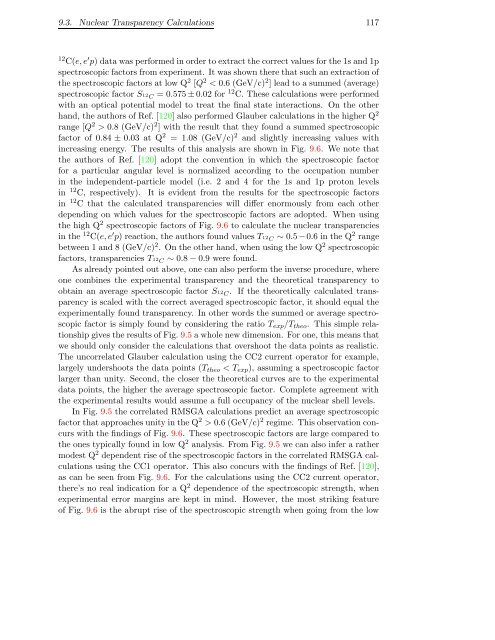Download Thesis in Pdf Format - Theoretical Nuclear Physics and ...
Download Thesis in Pdf Format - Theoretical Nuclear Physics and ...
Download Thesis in Pdf Format - Theoretical Nuclear Physics and ...
You also want an ePaper? Increase the reach of your titles
YUMPU automatically turns print PDFs into web optimized ePapers that Google loves.
9.3. <strong>Nuclear</strong> Transparency Calculations 117<br />
12 C(e, e ′ p) data was performed <strong>in</strong> order to extract the correct values for the 1s <strong>and</strong> 1p<br />
spectroscopic factors from experiment. It was shown there that such an extraction of<br />
the spectroscopic factors at low Q 2 [Q 2 < 0.6 (GeV/c) 2 ] lead to a summed (average)<br />
spectroscopic factor S12 C = 0.575 ± 0.02 for 12 C. These calculations were performed<br />
with an optical potential model to treat the f<strong>in</strong>al state <strong>in</strong>teractions. On the other<br />
h<strong>and</strong>, the authors of Ref. [120] also performed Glauber calculations <strong>in</strong> the higher Q 2<br />
range [Q 2 > 0.8 (GeV/c) 2 ] with the result that they found a summed spectroscopic<br />
factor of 0.84 ± 0.03 at Q 2 = 1.08 (GeV/c) 2 <strong>and</strong> slightly <strong>in</strong>creas<strong>in</strong>g values with<br />
<strong>in</strong>creas<strong>in</strong>g energy. The results of this analysis are shown <strong>in</strong> Fig. 9.6. We note that<br />
the authors of Ref. [120] adopt the convention <strong>in</strong> which the spectroscopic factor<br />
for a particular angular level is normalized accord<strong>in</strong>g to the occupation number<br />
<strong>in</strong> the <strong>in</strong>dependent-particle model (i.e. 2 <strong>and</strong> 4 for the 1s <strong>and</strong> 1p proton levels<br />
<strong>in</strong> 12 C, respectively). It is evident from the results for the spectroscopic factors<br />
<strong>in</strong> 12 C that the calculated transparencies will differ enormously from each other<br />
depend<strong>in</strong>g on which values for the spectroscopic factors are adopted. When us<strong>in</strong>g<br />
the high Q 2 spectroscopic factors of Fig. 9.6 to calculate the nuclear transparencies<br />
<strong>in</strong> the 12 C(e, e ′ p) reaction, the authors found values T12 C ∼ 0.5 − 0.6 <strong>in</strong> the Q 2 range<br />
between 1 <strong>and</strong> 8 (GeV/c) 2 . On the other h<strong>and</strong>, when us<strong>in</strong>g the low Q 2 spectroscopic<br />
factors, transparencies T12 C ∼ 0.8 − 0.9 were found.<br />
As already po<strong>in</strong>ted out above, one can also perform the <strong>in</strong>verse procedure, where<br />
one comb<strong>in</strong>es the experimental transparency <strong>and</strong> the theoretical transparency to<br />
obta<strong>in</strong> an average spectroscopic factor S12 C. If the theoretically calculated transparency<br />
is scaled with the correct averaged spectroscopic factor, it should equal the<br />
experimentally found transparency. In other words the summed or average spectroscopic<br />
factor is simply found by consider<strong>in</strong>g the ratio T exp /T theo . This simple relationship<br />
gives the results of Fig. 9.5 a whole new dimension. For one, this means that<br />
we should only consider the calculations that overshoot the data po<strong>in</strong>ts as realistic.<br />
The uncorrelated Glauber calculation us<strong>in</strong>g the CC2 current operator for example,<br />
largely undershoots the data po<strong>in</strong>ts (T theo < T exp ), assum<strong>in</strong>g a spectroscopic factor<br />
larger than unity. Second, the closer the theoretical curves are to the experimental<br />
data po<strong>in</strong>ts, the higher the average spectroscopic factor. Complete agreement with<br />
the experimental results would assume a full occupancy of the nuclear shell levels.<br />
In Fig. 9.5 the correlated RMSGA calculations predict an average spectroscopic<br />
factor that approaches unity <strong>in</strong> the Q 2 > 0.6 (GeV/c) 2 regime. This observation concurs<br />
with the f<strong>in</strong>d<strong>in</strong>gs of Fig. 9.6. These spectroscopic factors are large compared to<br />
the ones typically found <strong>in</strong> low Q 2 analysis. From Fig. 9.5 we can also <strong>in</strong>fer a rather<br />
modest Q 2 dependent rise of the spectroscopic factors <strong>in</strong> the correlated RMSGA calculations<br />
us<strong>in</strong>g the CC1 operator. This also concurs with the f<strong>in</strong>d<strong>in</strong>gs of Ref. [120],<br />
as can be seen from Fig. 9.6. For the calculations us<strong>in</strong>g the CC2 current operator,<br />
there’s no real <strong>in</strong>dication for a Q 2 dependence of the spectroscopic strength, when<br />
experimental error marg<strong>in</strong>s are kept <strong>in</strong> m<strong>in</strong>d. However, the most strik<strong>in</strong>g feature<br />
of Fig. 9.6 is the abrupt rise of the spectroscopic strength when go<strong>in</strong>g from the low















